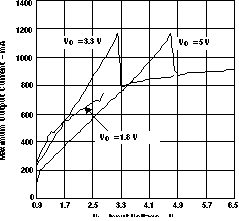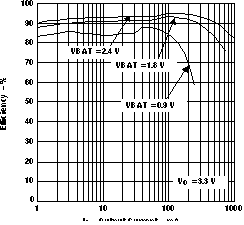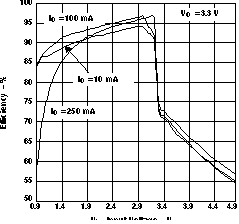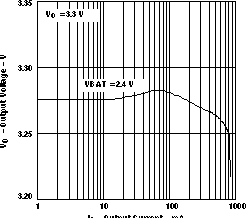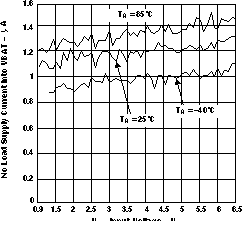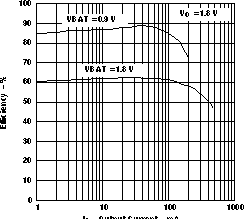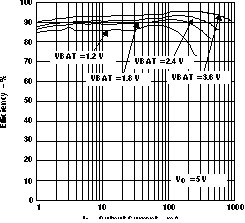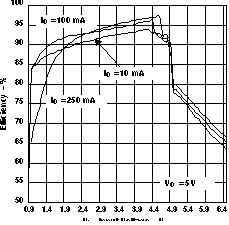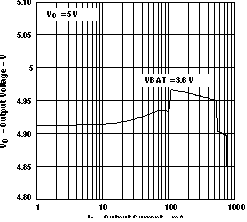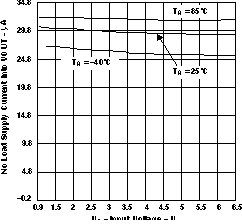SLVS451G September 2003 – December 2014 TPS61020 , TPS61024 , TPS61025 , TPS61026 , TPS61027 , TPS61028 , TPS61029
PRODUCTION DATA.
- 1 Features
- 2 Applications
- 3 Description
- 4 Typical Schematic
- 5 Revision History
- 6 Device Comparison Table
- 7 Pin Configuration and Functions
- 8 Specifications
- 9 Parameter Measurement Information
- 10Detailed Description
- 11Application and Implementation
- 12Power Supply Recommendations
- 13Layout
- 14Device and Documentation Support
- 15Mechanical, Packaging, and Orderable Information
Package Options
Mechanical Data (Package|Pins)
- DRC|10
Thermal pad, mechanical data (Package|Pins)
- DRC|10
Orderable Information
8 Specifications
8.1 Absolute Maximum Ratings
over operating free-air temperature range (unless otherwise noted)(1)| MIN | MAX | UNIT | ||
|---|---|---|---|---|
| Input voltage on SW, VOUT, LBO, VBAT, PS, EN, FB, LBI | –0.3 | 7 | V | |
| TJ | Operating virtual junction temperature | –40 | 150 | °C |
| Tstg | Storage temperature | –65 | 150 | °C |
(1) Stresses beyond those listed under Absolute Maximum Ratings may cause permanent damage to the device. These are stress ratings only, and functional operation of the device at these or any other conditions beyond those indicated under Recommended Operating Conditions is not implied. Exposure to absolute-maximum-rated conditions for extended periods may affect device reliability.
8.2 ESD Ratings
| VALUE | UNIT | |||
|---|---|---|---|---|
| V(ESD) | Electrostatic discharge | Human-body model (HBM), per ANSI/ESDA/JEDEC JS-001(1) | ±2000 | V |
| Charged-device model (CDM), per JEDEC specification JESD22-C101(2) | ±750 | |||
(1) JEDEC document JEP155 states that 500-V HBM allows safe manufacturing with a standard ESD control process. Manufacturing with less than 500-V HBM is possible with the necessary precautions.
(2) JEDEC document JEP157 states that 250-V CDM allows safe manufacturing with a standard ESD control process. Manufacturing with less than 250-V CDM is possible with the necessary precautions.
8.3 Recommended Operating Conditions
| MIN | NOM | MAX | UNIT | |
|---|---|---|---|---|
| Supply voltage at VBAT, VI (TPS61020, TPS61024, TPS61025, TPS61028) | 0.9 | 6.5 | V | |
| Supply voltage at VBAT, VI (TPS61026, TPS61029) | 0.9 | 5.5 | V | |
| Operating virtual junction temperature range, TJ | –40 | 125 | °C |
8.4 Thermal Information
| THERMAL METRIC(1) | TPS6102x | UNIT | |
|---|---|---|---|
| SON | |||
| 10 PINS | |||
| RθJA | Junction-to-ambient thermal resistance | 47.2 | °C/W |
| RθJC(top) | Junction-to-case (top) thermal resistance | 67.5 | |
| RθJB | Junction-to-board thermal resistance | 21.6 | |
| ψJT | Junction-to-top characterization parameter | 1.7 | |
| ψJB | Junction-to-board characterization parameter | 21.8 | |
| RθJC(bot) | Junction-to-case (bottom) thermal resistance | 3.6 | |
(1) For more information about traditional and new thermal metrics, see the IC Package Thermal Metrics application report, SPRA953.
8.5 Electrical Characteristics
Over recommended junction temperature range and over recommended input voltage range. Typical values are at TJ = 25°C (unless otherwise noted).| PARAMETER | TEST CONDITIONS | MIN | TYP | MAX | UNIT | ||
|---|---|---|---|---|---|---|---|
| DC-DC STAGE | |||||||
| VI | Minimum input voltage for start-up | RL = 120 Ω | 0.9 | 1.2 | V | ||
| Input voltage range, after start-up (TPS61020, TPS61024, TPS61025, TPS61027, TPS61028) | 0.9 | 6.5 | V | ||||
| Input voltage range, after start-up (TPS61026, TPS61029) | 0.9 | 5.5 | V | ||||
| VO | TPS61020, TPS61028 and TPS61029 output voltage range | 1.8 | 5.5 | V | |||
| VFB | TPS61020, TPS61028 and TPS61029 feedback voltage | 490 | 500 | 510 | mV | ||
| f | Oscillator frequency | 480 | 600 | 720 | kHz | ||
| ISW | Switch current limit (TPS61020, TPS61024, TPS61025, TPS61027) | VOUT= 3.3 V | 1200 | 1500 | 1800 | mA | |
| ISW | Switch current limit (TPS61028) | VOUT= 3.3 V | 800 | mA | |||
| ISW | Switch current limit (TPS61026, TPS61029) | VOUT= 3.3 V | 1500 | 1800 | 2100 | mA | |
| Start-up current limit | 0.4 x ISW | mA | |||||
| SWN switch on resistance | VOUT= 3.3 V | 260 | mΩ | ||||
| SWP switch on resistance | VOUT= 3.3 V | 290 | mΩ | ||||
| Total accuracy (including line and load regulation) | ±3% | ||||||
| Line regulation | 0.6% | ||||||
| Load regulation | 0.6% | ||||||
| Quiescent current | VBAT | IO = 0 mA, VEN = VBAT = 1.2 V, VOUT = 3.3 V, TA = 25°C |
1 | 3 | µA | ||
| VOUT | 25 | 45 | µA | ||||
| Shutdown current | VEN = 0 V, VBAT = 1.2 V, TA = 25°C |
0.1 | 1 | µA | |||
| CONTROL STAGE | |||||||
| VUVLO | Under voltage lockout threshold | VLBI voltage decreasing | 0.8 | V | |||
| VIL | LBI voltage threshold | VLBI voltage decreasing | 490 | 500 | 510 | mV | |
| LBI input hysteresis | 10 | mV | |||||
| LBI input current | EN = VBAT or GND | 0.01 | 0.1 | µA | |||
| VOL | LBO output low voltage | VO = 3.3 V, IOI = 100 µA | 0.04 | 0.4 | V | ||
| Vlkg | LBO output leakage current | VLBO = 7 V | 0.01 | 0.1 | µA | ||
| VIL | EN, PS input low voltage | 0.2 × VBAT | V | ||||
| VIH | EN, PS input high voltage | 0.8 × VBAT | V | ||||
| EN, PS input current | Clamped on GND or VBAT | 0.01 | 0.1 | µA | |||
| Overtemperature protection | 140 | °C | |||||
| Overtemperature hysteresis | 20 | °C | |||||
8.6 Typical Characteristics
Table 1. Table of Graphs
| FIGURE | ||
|---|---|---|
| Maximum output current | vs Input voltage (TPS61020) | Figure 1 |
| Efficiency | vs Output current (TPS61020) | Figure 2 |
| vs Output current (TPS61025) | Figure 3 | |
| vs Output current (TPS61027) | Figure 4 | |
| vs Input voltage (TPS61025) | Figure 5 | |
| vs Input voltage (TPS61027) | Figure 6 | |
| Output voltage | vs Output current (TPS61025) | Figure 7 |
| vs Output current (TPS61027) | Figure 8 | |
| No load supply current into VBAT | vs Input voltage | Figure 9 |
| No load supply current into VOUT | vs Input voltage | Figure 10 |
